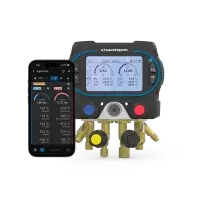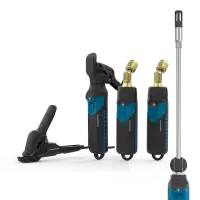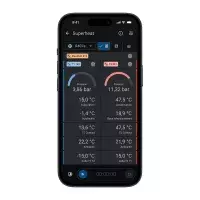Manifolds are digital manometers mainly used in the refrigeration, air conditioning and heat pump sectors. These digital refrigeration gauges measure pressure and vacuum, and are combined with temperature probes to measure the superheat and subcooling of over a hundred refrigerant gases.
In today's demanding HVACR industry, precision, efficiency, and data-driven insights are paramount. Whether you're a distributor supplying top-quality tools or an independent contractor performing installations and repairs, a digital manifold is no longer a luxury – it's a necessity. This comprehensive guide explores the benefits, features, and applications of HVACR digital manifolds, providing you with the knowledge to make informed decisions and elevate your work to the next level.
Benefits of Using a Digital Manifold for HVACR
Gone are the days of relying solely on analog gauges.Digital manifold gauges offer a significant upgrade, providing numerous advantages:
Unmatched Accuracy
Electronic manifold gauges deliver highly precise pressure and temperature readings, crucial for proper system charging, diagnosis, and performance optimization. Minimize errors and callbacks with pinpoint accuracy.
Enhanced Efficiency
Automated calculations for superheat, subcooling, and other vital parameters save valuable time and reduce the risk of manual calculation errors. Complete jobs faster and with greater confidence.
Data Logging and Reporting
Many digital manifolds with wireless connectivity allow you to record and store data, generating professional reports for clients or internal documentation. Track system performance over time and identify potential issues early.
Refrigerant Versatility
Easily switch between different refrigerants (R410A, R32, R134a, R22, R1234yf, and more) with pre-programmed refrigerant profiles. No need for manual calculations or multiple charts.
Simplified Diagnostics
Quickly identify system problems, such as restrictions, leaks, or improper charge levels, through accurate and readily available data.
Increased price/performance ratio
The benefits offered by this new generation of manifolds are extremely profitable for professionals, making these tools a worthwhile investment.
Choosing the Right Digital Manifold: Key Features and Considerations
Selecting the best digital manifold for HVAC depends on your specific needs and applications. Here are the key features to consider:
Accuracy and Precision: Why it Matters for Refrigeration and AC
Accuracy is non-negotiable in HVACR. A small error in pressure readings can lead to significant performance issues. Look for a digital manifold with high accuracy specifications and a robust sensor design.
Refrigerant Compatibility: R410A, R32, R134a, and More
Ensure the digital manifold supports the refrigerants you commonly work with. Most modern manifolds offer pre-programmed profiles for a wide range of refrigerants, including R410A, R32, R134a, R22, and newer alternatives like R1234yf.
Wireless Connectivity (Bluetooth/App): Streamlining Your Workflow
Wireless digital manifolds with Bluetooth connectivity and companion apps offer significant advantages. Stream data to your smartphone or tablet, generate reports, and even remotely monitor system performance.
Durability and Build Quality: Withstanding the Demands of the Job
HVACR work can be tough on tools. Choose a digital manifold built with durable materials and a rugged design to withstand daily use in challenging environments. Look for features like impact-resistant housing and water/dust resistance.
Display and User Interface: Clear Readings in Any Condition
A clear, easy-to-read display is essential, especially in low-light or bright sunlight conditions. Look for a backlit display with large, high-contrast digits. An intuitive user interface simplifies navigation and parameter selection.
Data Logging and Reporting: Simplifying Documentation and Analysis
Data logging capabilities allow you to record measurements over time, providing valuable insights into system performance. The ability to generate reports simplifies documentation and communication with clients.
Vacuum Gauge Integration: Essential for System Evacuation
A built-in digital manifold vacuum gauge is crucial for properly evacuating systems before charging. Look for a manifold with a high-quality vacuum sensor for accurate readings.
Price of a digital manifold
The digital manifold price may vary depending on many aspect, such as functionalities, brand, accuracy and quality. It is recommended to compare and contrast different models, in order to choose the one that suits your needs.
Applications of Digital Manifolds Across HVACR Sectors
Digital manifolds are versatile tools applicable across a wide range of HVACR applications:
Residential AC and Heat Pump Service
From routine maintenance to complex repairs, a digital manifold is essential for servicing residential air conditioning and heat pump systems. Accurately diagnose problems, charge systems correctly, and ensure optimal performance.
Commercial HVAC Maintenance and Repair
Commercial HVAC systems require precise diagnostics and maintenance. A digital manifold provides the accuracy and data logging capabilities needed to keep these systems running efficiently.
Industrial Refrigeration Systems
Industrial refrigeration systems operate under demanding conditions and require highly accurate measurements. A robust digital manifold for industrial refrigeration is crucial for maintaining system performance and preventing costly downtime.
Reversible Air Conditioning Systems
Digital manifolds are equally adept at servicing reversible air conditioning systems, providing accurate readings for both heating and cooling modes.
Frequently Asked Questions (FAQ) about Digital Manifolds
-
How does a manifold operate?
- To better understand how a manifold works, we recommend you read our article explaining how a heat pump operates (applicable to air conditioners and refrigeration systems where the circuit is simply reversed).
This refrigeration equipment is made up of several components to accomplish the tasks for which it is designed:
At its heart are pressure sensors. They fulfil the first function of a manifold: that of an accurate pressure gauge, robust enough to measure very high and low pressures. The low-pressure gauge monitors the pressure of the refrigerant on the suction side of the compressor, where the gas is in a vapour state at low pressure (cold). The high-pressure gauge monitors the pressure on the discharge side of the compressor, where the gas is in a highly compressed vapour state (hot).
Another very important component of manifolds is the connection valves. These connect the manifold to the various points in the closed circuit of the heat pump, air conditioning or refrigeration system, on the evaporator or condenser side.
Modern manifolds also incorporate two thermometers, which measure the temperature of the refrigerant. It is essential to measure the superheat and sub-cooling temperature, to know whether the refrigerant gas is cycling optimally between its different states. This is essential for analysing the state of the system and identifying any problems. Both thermometers use thermocouple measurement technology, which supports very wide temperature ranges. In addition, a good manifold makes it possible to measure the significant difference between the two temperatures under test at the same time as the pressures, to reduce operator intervention time.
An optional vacuum probe can also be added, to measure the vacuum in the refrigerant gas circuit during emptying, leak testing and gas replacement operations following repairs (typically to seal a leak). The vacuum meter typically measures the vacuum in the circuit before a gas refill, to ensure that no air or moisture remains. The presence of air would reduce the system's efficiency, and humidity is harmful to the compressor.
Manifolds are therefore one of the most sophisticated tools in the HVACR world, yet they are robust and, above all, easy to use!
- To better understand how a manifold works, we recommend you read our article explaining how a heat pump operates (applicable to air conditioners and refrigeration systems where the circuit is simply reversed).
-
How often should I calibrate my digital manifold?
- We recommend calibrating your digital manifold annually, or more frequently if it's subjected to heavy use or harsh conditions.
-
Can I use a digital manifold with all refrigerants?
- Most digital manifolds support a wide range of refrigerants, but it's crucial to check the specifications to ensure compatibility.
-
What is the advantage of a digital manifold with Bluetooth?
- Bluetooth connectivity allows you to wirelessly transmit data to a smartphone or tablet, simplifying data logging, report generation, and remote monitoring.
-
How do I clean and maintain my digital manifold?
- Regular maintenance and cleaning are crucial for optimal performance, follow carefully the instructions for your specific model.
-
How accurate should a digital vacuum gauge for manifolds be?
- Accuracy of a manifold vacuum probe must be within a few tens of microns.
Digital Manifold Price Range
The digital manifold price will vary a lot according to brands, quality, and functionalities. You can expect a price range from around $300 for the basic models, and up to $1000 for the models with the most advanced characteristics.
Invest in Efficiency and Accuracy with a Digital Manifold
A digital manifold is an investment that pays for itself through increased accuracy, efficiency, and improved diagnostics. Whether you're a distributor looking to offer the best tools to your customers or an HVACR technician striving for excellence, a digital manifold is an essential tool for success in the modern HVACR industry.




